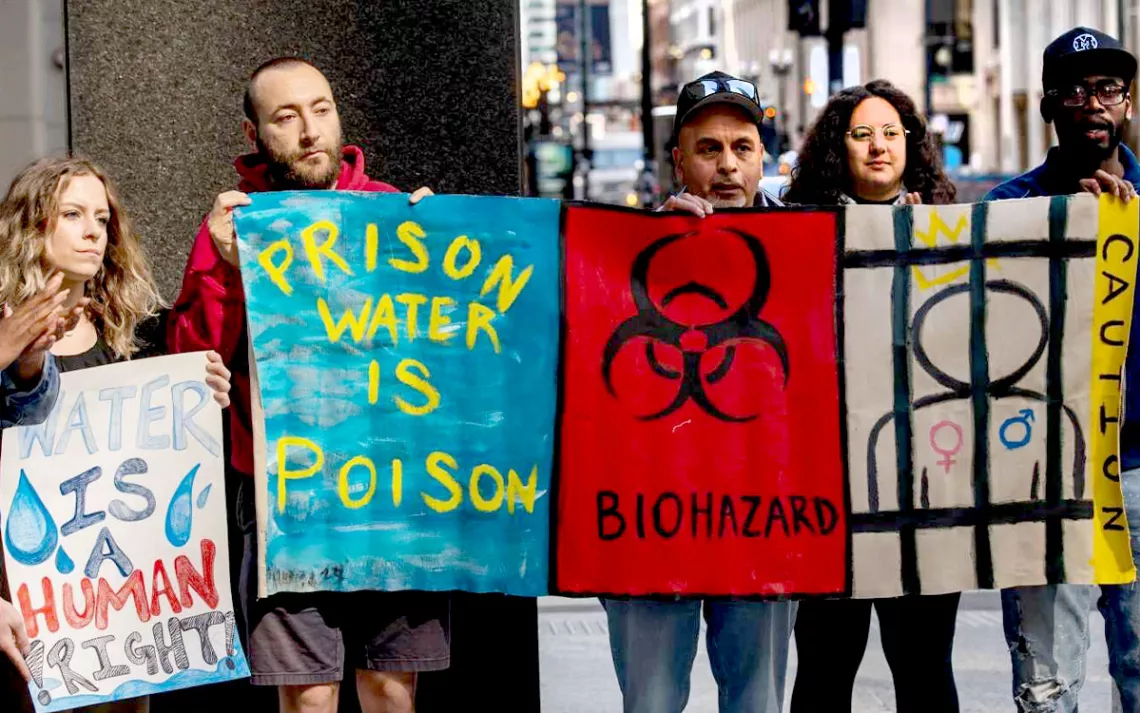Incarcerated People Are Drinking Unsafe Water in Illinois State Prisons
Prisoners' rights advocates and environmental groups are taking their concerns to the federal government

King Moosa (far right) and other advocates gather outside the EPA Region 5 office in Chicago on April 15 after delivering a petition urging the agency to address unsafe drinking water conditions in Illinois state prisons. | Photo courtesy of David Moran
Brian Harrington entered the Illinois Department of Corrections system in 2007 at age 14, sentenced to 25 years in prison. Three years later, he found himself at Menard Correctional Center, the largest maximum-security, state-run prison in Illinois, subjected to living conditions he now describes as unfair, degrading, and inhumane.
He remembers the toilet water being brown—and sometimes the drinking water, too. He recalls the tap water’s sewer smell and the black specks swirling, then settling, in his cup. After showering, his skin would feel gritty and his white towel would turn brown while drying off.
“For a kid that’s coming into this adult facility, I just thought this is the way it is, that’s what I have to endure,” said Harrington, a Chicago-based hip hop artist and activist who goes by King Moosa, or Moosa.
Moosa, who was released in 2020 via a clemency petition, now knows that’s not the case. And as a community organizer with the Coalition to Decarcerate Illinois, he’s been helping to call out the Department of Corrections for the dirty water that Menard and 29 of the state’s other facilities have, for decades, knowingly provided to incarcerated people—a crisis that is only worsening.
After years of inaction by the department and the Illinois EPA that regulates it, the coalition, prisoner’s rights and environmental groups and other advocates are now taking their concerns to the federal government.
On April 15, they filed a legal petition urging the United States EPA to take emergency action to address unsafe drinking water in Illinois’ correctional facilities that comes from aging and neglected plumbing. The petitioners are asking the EPA to use its “imminent and substantial endangerment” authority under the Safe Drinking Water Act to help protect as many as 30,000 incarcerated people. Until now, such petitions have requested the EPA target failures with municipal water supply systems—in Flint, Michigan, for example. This petition is the first to ask the agency to apply its emergency authority to intervene in a prison context.
“There's no system-wide effort being made to actually understand drinking water quality in these prisons,” said Robert A. Weinstock, director of the Environmental Advocacy Center at Northwestern Pritzker School of Law, noting that testing only happens when required by the Illinois EPA or as the result of outside pressure. “You can look at individual facilities, but there's a bigger picture here. Every facility that's being run by [the Illinois Department of Corrections] is putting people's health at risk,” Weinstock added.
Over the past few years, the department’s own water sampling has detected Legionella bacteria at a dozen facilities, high levels of lead and copper, and harmful levels of chlorine. But because of strict security protocols, independent water testing has been nearly impossible, so many details of contamination and structural deficiencies are based on complaints by incarcerated people and visitor observation.
Months after his release, Moosa found himself at the hospital, throwing up blood. Doctors eventually diagnosed him with a rare autoimmune condition that causes a low platelet count, and he believes the conditions he experienced during his decade at Menard were, at the very least, a contributing factor. While incarcerated, he observed others with rampant digestive issues, skin problems, and cancer diagnoses. And, now, in his role with the coalition, he receives regular updates on water quality and health issues from currently incarcerated people. In the past few months alone, they’ve shared reports of boil orders and a lack of both running and bottled water, in addition to individual complaints of rusty-tasting water, burning skin, throat irritation, and a positive test for Legionnaires' disease.
“I think having old pipes, and people ingesting things that you're not supposed to ingest, is very much to blame for a lot of the medical issues happening on the inside right now,” Moosa said. He also remembers the "psychological torture" of seeing state prison officers chug their own bottled water, which was especially painful to watch during extreme heat conditions. “Just because we plead guilty it doesn’t mean we need to subject ourselves to inhumane conditions,” Moosa said. “That wasn’t part of the deal.”
Joel Davis agrees, and adds that these issues are far from new. He was just released in February after spending 35 years in the system, 22 of which were at Stateville Correctional Center, another maximum-security facility. From the moment he entered the system in 1995, people told him the water was bad. It was brown, smelly, and made your skin itch, he recalled. Guards refused to drink it, even back then. Davis has also hung onto a 2001 memo alerting those at Stateville that radium levels in the water had tested 2.5 times higher than the maximum contaminant limit—the last written communication about water quality he remembers receiving.
“You couldn't be in a prison and not experience it,” Davis said. He hoarded the bottled water he bought on the commissary to drink, brush his teeth, and wash his face. He turned vegan, and he refused to eat anything that had been cooked using Stateville’s tap water. “But you’re stuck there, you don’t have a choice in the matter,” he said. “The only thing you can hope is somebody will take this up and fight that fight for you.”
Groups like the Coalition to Decarcerate Illinois and Uptown People’s Law Center have been doing just that, raising awareness and calling for urgent reforms for years. In 2022, Uptown People's Law Center, with the Natural Resources Defense Council, conducted an informal survey of people incarcerated at Vienna Correctional Center, located about five hours south of Chicago, and the majority of respondents cited widespread water quality problems and health concerns. The results led to an investigation by the EPA, which found Vienna's entire water system—including a leaking retention tank with holes being plugged by sticks—in need of immediate repair. What’s more, the onsite lake that supplies Vienna’s water has a history of developing harmful algal blooms, subjecting those incarcerated to the toxins the blooms produce. Ingesting, inhaling, or submerging in water contaminated with cyanotoxins, as they’re known, can cause severe illness and death in humans, too.
The following year, the state of Illinois commissioned a rare independent assessment to evaluate the state of its correctional facilities, some of which are more than a century old. The study determined that the system had $2.5 billion worth of deferred maintenance and only three of the 27 facilities that the independent consulting firm reviewed fell into the "Fully Operational" category.
This decades-long pattern of systemic neglect sits at the heart of the advocates’ recent petition to the EPA. “A prison sentence is not a license for the state to deprive people of basic necessities,” they state, stressing the urgent need for the agency to “swiftly get incarcerated people out of harm’s way.” Some of their suggestions include providing free bottled water within the facilities, expert assessment of the infrastructure and rapid implementation of upgrades, and the use of transfers, good time credits, medical release, home confinement, and clemency to protect those directly impacted.
The petitioners argue that the activation of the EPA’s emergency authority not only falls under the requirements of the Safe Drinking Water Act but also that it aligns with the Biden administration’s wider commitment to promoting environmental justice. Half of the population in Illinois’ state prisons is Black, and many come from, and will return to, communities that bear an unjust environmental burden. The EPA itself has named the act’s emergency authority as an important tool in addressing matters of environmental justice, including the cumulative impacts of multiple sources of pollution that many communities face.
The petition has already caught the attention of government officials and, over the past few months, the urgency of the emergency action request has increased for the petitioners. On May 10, the EPA sent Weinstock a one-paragraph acknowledgement of its receipt, communicating that the agency is reviewing the information and considering its next steps. “Ensuring all Public Water Systems are providing water that meets the standards of the Safe Drinking Water Act is one of EPA’s highest priorities,” it stated.
On July 2, Illinois State Senator Rachel Ventura, whose district includes Stateville, sent a letter of “strong support” for the petition to the EPA’s regional administrator. Just last week, after learning about potential fraudulent water testing data at Stateville and new reports of unsafe conditions at other prisons, advocates sent a follow-up letter to the EPA stressing the need for immediate federal intervention.
The main focus of the petition is ensuring the immediate safety of people incarcerated in Illinois state prisons, and advocates also see their request as potentially having a broader impact. “We have every reason to believe that these conditions are not unique to Illinois prisons,” Weinstock said. Prison facilities are aging in states across the country, and reports of similar health issues have sprung up from New York to California.
“I don't believe in prisons, but I also know that prison isn't going anywhere,” Moosa said. “Not today, not tomorrow, not in 10 years. So we need to make these facilities livable.”
 The Magazine of The Sierra Club
The Magazine of The Sierra Club



